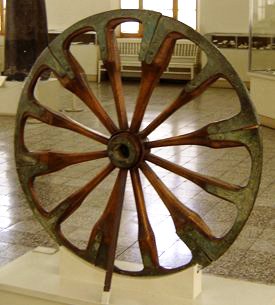
A spoke is one of some number of rods radiating from the center of a wheel, connecting the hub with the round traction surface.
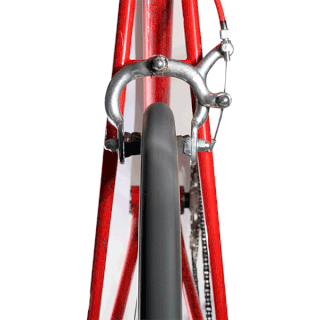
A bicycle brake reduces the speed of a bicycle or prevents it from moving. The three main types are: rim brakes, disc brakes, and drum brakes.

A spoke wrench or spoke key is a small wrench or tool used to adjust the tension in the spokes of a tension-spoked wheel. A spoke wrench is sometimes called a nipple wrench, as it is the spoke nipple – not the spoke – that is turned in the process of changing the tension of a spoke.

A bicycle frame is the main component of a bicycle, onto which wheels and other components are fitted. The modern and most common frame design for an upright bicycle is based on the safety bicycle, and consists of two triangles: a main triangle and a paired rear triangle. This is known as the diamond frame. Frames are required to be strong, stiff and light, which they do by combining different materials and shapes.
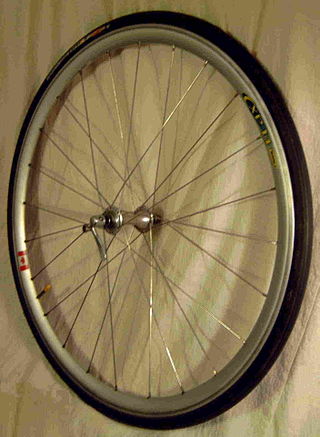
A bicycle wheel is a wheel, most commonly a wire wheel, designed for a bicycle. A pair is often called a wheelset, especially in the context of ready built "off the shelf" performance-oriented wheels.
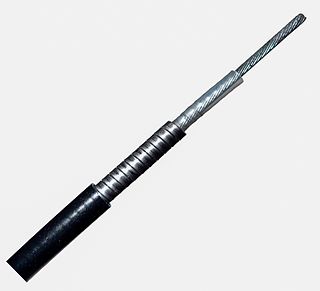
A Bowden cable is a type of flexible cable used to transmit mechanical force or energy by the movement of an inner cable relative to a hollow outer cable housing. The housing is generally of composite construction, consisting of an inner lining, a longitudinally incompressible layer such as a helical winding or a sheaf of steel wire, and a protective outer covering.

A touring bicycle is a bicycle designed or modified to handle bicycle touring. To make the bikes sufficiently robust, comfortable and capable of carrying heavy loads, special features may include a long wheelbase, frame materials that favor flexibility over rigidity, heavy duty wheels, and multiple mounting points.

The headset is the set of components on a bicycle that provides a rotatable interface between the bicycle fork and the head tube of a bicycle frame. The tube through which the steerer of the fork passes is called the head tube. A typical headset consists of two cups that are pressed into the top and bottom of the headtube. Inside the two cups are bearings which provide a low friction contact between the bearing cup and the steerer.

A bicycle fork is the part of a bicycle that holds the front wheel.
The term bicycle tools usually refers to specialty tools only used on bicycles, as opposed to general purpose mechanical tools such as spanners and hex wrenches. Various bicycle tools' have evolved over the years into specialized tools for working on a bicycle. Modern bicycle shops will stock a large number of tools for working on different bicycle parts. This work can be performed by a trained bicycle mechanic, or for simple tasks, by the bicycle owner.
29ers or two-niners are mountain bikes and hybrid bikes that are built to use 700c or 622 mm ISO wheels, commonly called 29" wheels. Most mountain bikes once used ISO 559 mm wheels, commonly called 26" wheels. The ISO 622 mm wheel is typically also used for road-racing, trekking, cyclo-cross, touring and hybrid bicycles. In some countries, mainly in Continental Europe, ISO 622 mm wheels are commonly called 28" wheels or "28 Incher".

Wheelbuilding is the process of assembling wire wheels. The components of a wire wheel are the rim, spokes, nipples, and hub.

Zipp is an American company that is best known for designing, manufacturing, and marketing carbon-composite bicycle wheels for road cycling, triathlons, track racing, and mountain biking. The company's product range also includes handlebars, stems, seat posts, tires, inner tubes, handlebar tape, and bags.

A wheel truing stand is a specialized tool for "truing" (straightening) bicycle wheels. Individual models differ slightly, but all consist of an axle stand on which the wheel can rotate and calipers, to measure slight deviations of the wheel's rim from ideal alignment. Proper wheel alignment includes lateral, radial and dish/centering trues which keep the wheel straight and strong. The stand is used in conjunction with an appropriately sized spoke wrench to loosen or tighten the spokes that connect the wheel's hub to the rim.
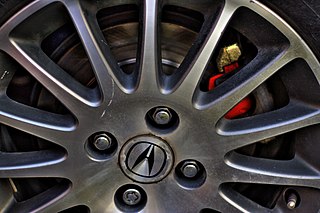
A lug nut or wheel nut is a fastener, specifically a nut, used to secure a wheel on a vehicle. Typically, lug nuts are found on automobiles, trucks (lorries), and other large vehicles using rubber tires.

Wire wheels, wire-spoked wheels, tension-spoked wheels, or "suspension" wheels are wheels whose rims connect to their hubs by wire spokes. Although these wires are considerably stiffer than a similar diameter wire rope, they function mechanically the same as tensioned flexible wires, keeping the rim true while supporting applied loads. The term suspension wheel should not be confused with vehicle suspension.

A screw and a bolt are similar types of fastener typically made of metal and characterized by a helical ridge, called a male thread. Screws and bolts are used to fasten materials by the engagement of the screw thread with a similar female thread in a matching part.

A bolt is a form of threaded fastener with an external male thread requiring a matching pre-formed female thread such as a nut. Bolts are very closely related to screws.

Mountain bike trials, also known as observed trials, is a discipline of mountain biking in which the rider attempts to pass through an obstacle course without setting foot to ground. Derived from motorcycle trials, it originated in Catalonia, Spain as trialsín and is said to have been invented by Pere Pi, the father of Ot Pi, a world champion motorcycle trials rider. Pi's father had wanted his son to learn motorcycle trials by practicing on an ordinary bicycle.


















